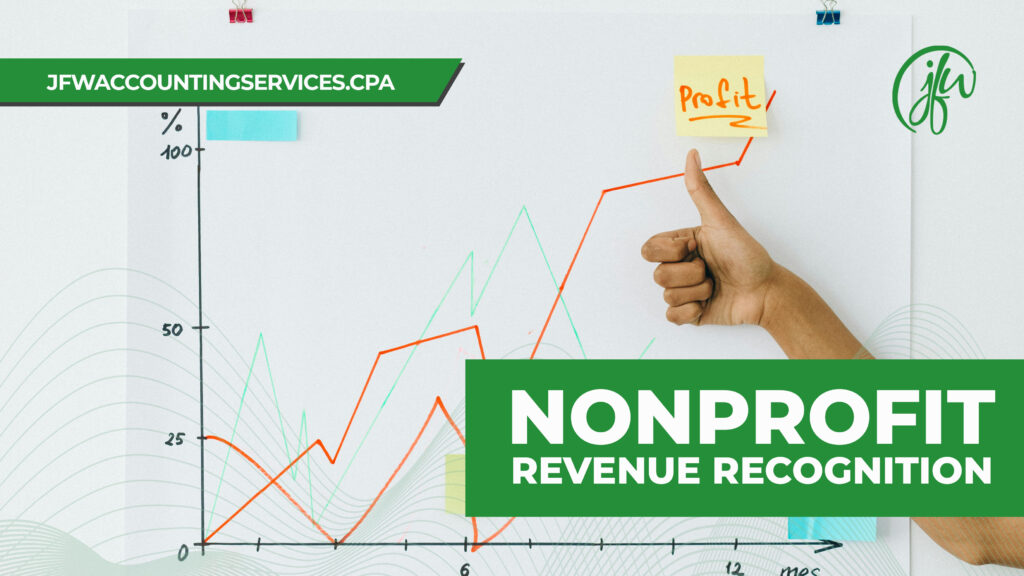The end-of-month financial review can feel overwhelming. The grants have specific restrictions, donations flow inconsistently, and membership dues need careful tracking. Questions about compliance and transparency linger in your mind—are these numbers telling the whole story?
Nonprofit revenue recognition is more than an accounting requirement; it’s the foundation for trust and accountability. Each revenue stream carries unique complexities; without transparent processes, missteps can lead to donor mistrust or regulatory issues. The updated FASB standards, such as Topic 606 and ASU 2018-08, add another layer of complexity, often leaving leaders navigating a maze of rules while striving to keep their mission on course.
In this guide, we’ll explore the nuances of revenue recognition, unravel key terms, and share strategies to simplify compliance. With the right tools and understanding, you can turn this challenge into an opportunity for clarity and strengthened trust.
Revenue Recognition for Nonprofits
Understanding nonprofit revenue recognition is more than just a technical exercise—it’s the foundation for financial clarity and organizational trust. To tackle the challenges of managing diverse revenue streams, nonprofits must first grasp what revenue recognition entails and why it’s crucial. Let’s start by breaking down the principles and processes that define nonprofit revenue recognition and how they shape your financial strategy.
What is Revenue Recognition for Nonprofits?
Nonprofit revenue recognition is determining when and how to record income accurately. It ensures revenue is documented at the right time and under the correct conditions, following established accounting guidelines. This process is critical for maintaining compliance with Financial Accounting Standards Board (FASB) regulations and upholding transparency with donors and stakeholders.
FASB standards classify revenue into two categories:
- Contributions (ASC 958-605): These are non-reciprocal transactions where donors do not receive equivalent value in return, such as unrestricted gifts or donations to a capital campaign.
- Exchange Transactions (Topic 606): These are reciprocal transactions, such as membership dues or ticket sales, in which the nonprofit provides goods or services in return for revenue.
Proper nonprofit revenue recognition is vital for accurate financial reporting, as it directly impacts audits, tax filings, and decision-making. Beyond compliance, it strengthens donor confidence by demonstrating accountability and reliability. Recording a grant as conditional until meeting its requirements ensures accuracy and builds trust with funders.
Understanding and implementing robust revenue recognition practices give nonprofit leaders the knowledge to align their financial records with mission-driven goals, fostering transparency and long-term sustainability.
Criteria for Revenue Recognition
Under FASB Topic 606, nonprofits recognize revenue using a five-step framework to ensure transparency and compliance when accounting for exchange transactions. This process is particularly relevant for nonprofits with membership programs, ticketed events, or program service fees.
So, what are the 5 criteria for revenue recognition?
(1) Identify the contract with a customer:
A contract exists when a nonprofit and a customer agree on the terms of the exchange. For example, a membership agreement or ticket sale establishes this contractual relationship.
(2) Identify the performance obligations:
Performance obligations are the specific promises made in the contract. For a nonprofit, this could include providing access to exclusive content, hosting events, or delivering services tied to a membership fee.
(3) Determine the transaction price:
The transaction price is the total amount the nonprofit expects to receive in exchange for fulfilling its obligations. For example, a $100 annual membership fee represents the transaction price.
(4) Allocate the transaction price to performance obligations:
If the contract includes multiple obligations (e.g., event tickets and a monthly newsletter), the nonprofit must allocate the transaction price proportionally based on the value of each obligation.
(5) Recognize revenue when (or as) performance obligations are satisfied:
Nonprofits recognize revenue once they fulfill their obligations. For example, they recognize revenue from a ticketed event when it occurs and from a membership fee paid monthly throughout the membership period.
This five-step framework helps nonprofits maintain compliance and ensures their financial reporting aligns with their income’s actual timing and nature. By following these principles, nonprofits can accurately reflect their financial health while building stakeholder trust.
Now that we’ve explored the foundational criteria for nonprofit revenue recognition let’s examine its practical application to grant revenue.
How to Recognize Grant Revenue
Grant revenue recognition varies depending on the grant type, making it essential for nonprofits to understand and apply proper accounting practices. So, how do we recognize grant revenue?
Types of Grants and Their Recognition

Unconditional Grants
Nonprofits recognize revenue from unconditional grants immediately after receiving the award. Without performance obligations or contingencies, they immediately record the funds as income.
Conditional Grants
Grants require nonprofits to meet specific conditions—such as achieving milestones or incurring qualifying expenses—before they can recognize revenue. For example, nonprofits recognize a foundation grant tied to hosting a community event only after the event occurs.
Reimbursable Grants
Nonprofits recognize revenue from reimbursable grants after incurring and submitting documentation for qualifying expenses. For example, they can only recognize revenue from federal grants with cost-reimbursement requirements once the costs are reviewed and reimbursed.
Steps to Ensure Compliance

Review Grant Agreements
Examine the grant’s terms to determine whether it includes conditions or restrictions. Conditions delay recognition until obligations are fulfilled, whereas restrictions detail how to use the funds.
Maintain Accurate Documentation
To substantiate revenue recognition, keep detailed records of expenses, progress, and milestone achievements. This will ensure compliance during audits and help maintain donor trust.
Example: A federal cost-reimbursement grant may require a nonprofit to submit expense reports monthly. The nonprofit recognizes revenue only after the federal agency reimburses the documented expenses.
Contributions: Conditional vs. Unconditional
In nonprofit revenue recognition, distinguishing between conditional and unconditional contributions is essential for accurate financial reporting. Correctly classifying these contributions ensures compliance with FASB standards and provides a clear picture of an organization’s economic health.
Unconditional Contributions
Unconditional contributions have no donor-imposed conditions and can be recognized immediately upon receipt or pledge.
Common examples include general donations to an annual fundraising campaign or unrestricted grants. Since there are no barriers to overcome or risks of forfeiture, unconditional contributions simplify revenue recognition, allowing nonprofits to allocate resources without delay.
Conditional Contributions
Conditional contributions, on the other hand, come with specific requirements that must be fulfilled before the nonprofit can recognize the revenue. These conditions often include measurable performance goals, matching requirements, or stipulations outlined in funding agreements.
Examples include grants contingent on hosting several community events or a matching gift that activates only when reaching the fundraising target.
Two key elements define conditional contributions:
(1) Presence of a barrier
The nonprofit must meet a measurable obligation, such as delivering a service or reaching a milestone.
(2) Right of return or release
The donor retains the right to reclaim the funds or cancel the obligation if the nonprofit fails to meet the conditions.
Conditions vs. Restrictions
It’s important to differentiate between conditions and restrictions. Conditions postpone revenue recognition until nonprofits meet specific criteria. Restrictions dictate how funds can be used but do not affect when nonprofits recognize revenue.
Nonprofits recognize a donation restricted to funding scholarships immediately if no conditions exist, but they delay recognizing a conditional promise until they meet its requirements.
What Is Considered Revenue for a Nonprofit?
Revenue for a nonprofit encompasses a range of sources that support the organization’s mission and operations. So, what is considered revenue for a nonprofit?
Types of Nonprofit Revenue

Contributions
These include donations from individuals, crowdfunding campaigns, and employer matches. Contributions are often categorized as conditional or unconditional, affecting their recognition.
Exchange Transactions
These are revenue generated from reciprocal exchanges, such as membership fees, ticket sales, and program service fees. In these transactions, the nonprofit provides goods or services in return.
Other Revenue
This category includes investments, endowments, and income from special events. These sources may require additional tracking for restrictions or donor specifications.
Importance of Categorizing Revenue Correctly
Proper revenue categorization is critical to complying with FASB standards and providing transparent financial reports. Accurate revenue reporting builds trust among donors, grantmakers, and stakeholders by demonstrating financial accountability and supporting informed decision-making.
Nonprofit Revenue Recognition Best Practices
Categorizing revenue correctly is just the beginning. Organizations must adopt best practices that streamline processes, enhance accuracy, and maintain compliance to manage nonprofit revenue recognition effectively. From implementing robust policies to leveraging advanced accounting tools, these practices ensure sustainable financial stewardship. Let’s explore how nonprofits can set up systems for success:
Implement a Comprehensive Revenue Recognition Policy
Develop clear policies tailored to your organization’s operations. These policies should outline procedures for categorizing, documenting, and recognizing revenue sources.
Track Revenue Sources Diligently
Classify revenue as exchange transactions, contributions, or hybrids to ensure proper treatment. Identify donor-imposed conditions or restrictions upfront to prevent misclassification.
Invest in Advanced Accounting Tools
Leverage platforms like Sage Intacct to automate processes, centralize documentation, and generate GAAP-compliant financial reports in real-time. Automation reduces errors and simplifies compliance tracking.
Stay Updated on Regulatory Changes
Familiarize your team with the updates to ASC 606 and ASU 2018-08. Then, review these standards regularly to ensure your organization’s practices align with current regulations.
Train Your Finance Team
Equip your team with the knowledge and skills to understand and apply revenue recognition standards. Regular training minimizes errors and strengthens financial stewardship.
Sage Intacct Simplifies Revenue Recognition
Implementing best practices lays the groundwork for effective nonprofit revenue recognition. However, nonprofits can take this further by leveraging specialized tools like Sage Intacct. This cloud-based solution simplifies compliance and automates complex processes, enabling nonprofits to focus on their mission. Let’s examine how Sage Intacct transforms revenue recognition for nonprofits.
Overview of Sage Intacct’s Features
Sage Intacct offers advanced tools designed to automate and streamline nonprofit revenue recognition. It ensures compliance with key standards such as ASC 606 and ASC 958-605 while providing real-time tracking of conditional and restricted funds. Additionally, it generates precise financial reports that align with GAAP requirements, giving nonprofits a clear and accurate financial picture.
Benefits for Nonprofits

Saves Time and Reduces Errors
By automating revenue recognition processes, Sage Intacct eliminates manual calculations and reduces the risk of errors, freeing up valuable staff time.
Improves Financial Transparency and Accountability
With centralized documentation and reporting, nonprofits can easily demonstrate accountability to donors and stakeholders.
Provides Insights for Better Decision-Making
Dynamic dashboards and real-time analytics help nonprofit leaders make informed decisions and align resources with their mission.
Sage Intacct is a transformative solution for nonprofits seeking to optimize their revenue recognition processes and enhance compliance.
Learn more about Sage Intacct for Nonprofits.
Conclusion
Nonprofit organizations need proper revenue recognition to ensure compliance, maintain transparency, and build stakeholder trust. By implementing best practices and leveraging advanced tools like Sage Intacct, nonprofits can simplify complex processes, reduce errors, and enhance decision-making capabilities.
At JFW Accounting Services, we understand nonprofits’ unique challenges in managing their financial systems. Our team of experts helps organizations align their accounting practices with mission-driven goals.
Take the next step toward financial clarity and sustainability—contact JFW Accounting Services today for expert guidance and tailored solutions.

Jo-Anne Williams Barnes, is a Certified Public Accountant (CPA) and Chartered Global Management Accountant (CGMA) holding a Master’s of Science in Accounting (MSA) and a Master’s in Business Administration (MBA). Additionally, she holds a Bachelor of Science (BS) in Accounting from the University of Baltimore and is a seasoned accounting professional with several years of experience in the field of managing financial records for non-profits, small, medium, and large businesses. Jo-Anne is a certified Sage Intacct Accounting and Implementation Specialist, a certified QuickBooks ProAdvisor, an AICPA Not-for-Profit Certificate II holder, and Standard for Excellence Licensed Consultant. Additionally, Jo-Anne is a member of American Institute of Certified Public Accountant (AICPA), Maryland Association of Certified Public Accountants (MACPA), and Greater Washington Society of Certified Public Accountants (GWSCPA) where she continues to keep abreast on the latest industry trends and changes.

